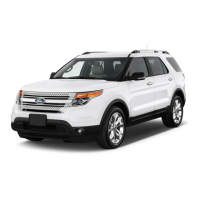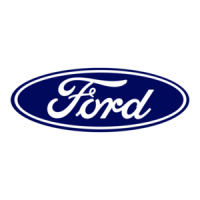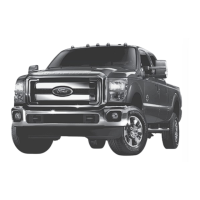
Do you have a question about the Ford 2012 Explorer and is the answer not in the manual?
| Brand | Ford |
|---|---|
| Model | 2012 Explorer |
| Category | Automobile |
| Language | English |
Information on safety warnings, environmental protection, and vehicle symbols. Covers reducing risks and observing warning symbols.
Explanation of warning lights and chimes that alert the driver to vehicle conditions or malfunctions.
Details on the tachometer, multifunction display, and other gauges in the instrument cluster.
Information on the vehicle's message center for monitoring systems and configuring features.
Overview of the MyFord Touch system, including its touchscreen interface and navigation.
Instructions for using the vehicle's USB port for media devices and charging.
Information on the SYNC system's hands-free communication and media features.
Details on the manual climate control system with rear climate controls.
Details on the Dual Automatic Temperature Control (DATC) system and its features.
Instructions on how to operate the rear window defroster control.
How climate control operates during remote start based on outside temperature.
Information on the vehicle's cabin air filter and its replacement.
Explanation of the headlamp control knob and its functions.
Instructions on how to activate and deactivate the fog lamps.
Instructions for adjusting the brightness of the instrument panel and interior lights.
Details on operating windshield wipers, including rain-sensing features.
Instructions on how to adjust the steering wheel's position.
Information on operating power windows, including one-touch features.
Details on the interior rearview mirror and its automatic dimming function.
Instructions for adjusting power side view mirrors and their memory feature.
How to use the speed control system to maintain a set speed.
Explanation of the adaptive cruise control system and its limitations.
How to use the automatic steering feature for parking.
Information on integrated keyhead transmitters (IKTs) and intelligent access keys (IA keys).
Details on the MyKey feature for programming restricted driving modes.
How to use the keyless entry keypad for locking, unlocking, and programming codes.
Explanation of the SecuriLock passive anti-theft system and its operation.
Safety precautions and adjustments for front seats, head restraints, and lumbar support.
Guidelines for proper use of safety belts and their locking modes.
Information about airbags, SRS operation, and safety precautions.
Instructions for properly using child safety seats and restraints.
Information on the TPMS, including warning lights and malfunction indicators.
Guidelines for using snow tires and cable chains on the vehicle.
Guidance on proper vehicle loading and weight capacities.
Guidelines and recommendations for safe trailer towing.
Instructions on starting the vehicle, including push button start system.
Explanation of the AdvanceTrac with RSC system's stability enhancement features.
How to use the hill descent control feature for maintaining speed on steep grades.
Information on the reverse sensing system and its limitations.
How to use the rearview camera system for assistance while reversing.
Details on the collision warning system with brake support.
How to use the active park assist system for parallel parking.
Information on BLIS and CTA systems for driver assistance.
Information on Ford's complimentary roadside assistance program.
Procedure for restarting the vehicle after a fuel pump shut-off.
Guide to fuse amperage ratings, colors, and protected circuits.
Step-by-step instructions for changing a flat tire.
Procedure for jump starting a disabled vehicle using jumper cables.
Recommendations for proper vehicle towing procedures.
Information on obtaining warranty repairs and service.
How to report vehicle safety defects to NHTSA and Ford Motor Company.
Instructions for washing the vehicle's exterior, including proper products and techniques.
Guidelines for cleaning the engine compartment and its components.
How to clean the vehicle's dashboard, interior trim, and cluster lens.
Overview of routine maintenance services and precautions.
Instructions on how to open the vehicle's hood.
Diagrams and labels identifying key engine compartment components.
Instructions for checking and adding windshield washer fluid.
Procedure for checking and adding engine oil.
Information on the vehicle's maintenance-free battery and its care.
Guidance on checking and adding engine coolant.
Coolant recommendations for different climate conditions.
How the vehicle manages engine temperatures during severe conditions.
Information about the vehicle's lifetime fuel filter.
Safety precautions and guidelines for handling automotive fuels.
Fuel octane recommendations for different engine types.
Tips and methods for calculating and improving vehicle fuel economy.
Information on emission control components and catalytic converter care.
Explanation of the OBD-II system for emission monitoring.
Understanding I/M testing readiness and potential issues.
Instructions for checking and adding brake fluid.
How to check automatic transmission fluid levels.
Instructions for changing the air filter element.
Recommendations for storing the vehicle for extended periods.
List of Motorcraft part numbers for common vehicle components.
Specifications and capacities for various vehicle maintenance products.
Technical data for the vehicle's engines.
Information on locating the Safety Compliance Certification Label and VIN.
Overview of available Ford Custom Accessories and warranty information.
Details on Ford ESP coverage, components, and benefits.
Explanation of how Ford ESP can save money on maintenance and repairs.
Importance of vehicle maintenance for reliability, durability, and resale value.
Basic maintenance checks and inspections to be performed by the owner.
Recommended multi-point inspection items for each service visit.
Information on the Intelligent Oil Life Monitor and maintenance schedule.












